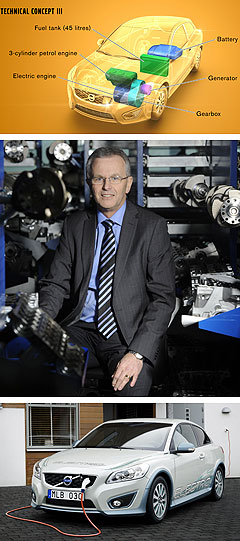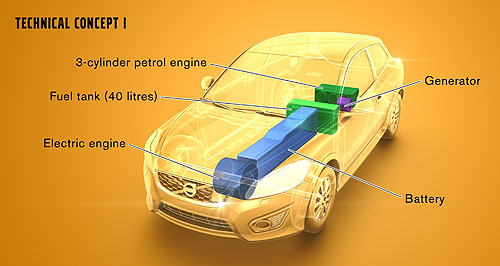Make / Model Search
Future models - Volvo - C30 - Extended Range EVVolvo adds 1000km to EV rangeGreen tint: Volvo has unveiled three different range-extended electric vehicle concepts which combine electric motors with petrol-powered engines. Swedish car-maker Volvo to begin tests on petrol-assisted EVs in early 201214 Jul 2011 VOLVO Cars has taken another step in its electric car development program by unveiling three different range-extender EV prototypes which use traditional petrol-powered combustion engines to complement the main electric motor and battery pack. The projects, including two different prototypes based on the C30 small car and one on the V60 mid-sized wagon, are being supported financially by the Swedish Energy Agency to the tune of €1.2 million ($A1.6m) and will undergo testing in the first quarter of 2012. The prototypes appear to share some similarities with existing plug-in hybrid vehicles such as the petrol-electric Chevrolet Volt and Volvo’s own diesel-electric V60 PHEV, which is likely to be the company’s first EV in Australia when it arrives here within two years. Plug-in hybrid drivetrains such as these confront the issue of ‘range anxiety’ in battery-powered cars by increasing the claimed maximum driving distance, which in the case of all three technical concepts is claimed to be more than 1000km. “Battery cost and size mean that all-electric cars still have a relatively limited operating range,” said Volvo Car Corporation’s vice-president of powertrain engineering Derek Crabb. “With the range extender, the electric car has its effective range increased by a thousand kilometres – yet with carbon dioxide emissions below or way below 50g/km.” The complementary combustion engine in each prototype is a three-cylinder unit with different levels of tune that can run on both petrol and E85 ethanol and is located in either the rear of the car or under the bonnet, depending on the model.  Left: Diagram of a Volvo V60-based 'technical concept III'. Middle: Volvo Car Corporation’s vice-president of powertrain engineering Derek Crabb. Bottom: Volvo C30 Electric DRIVe. Left: Diagram of a Volvo V60-based 'technical concept III'. Middle: Volvo Car Corporation’s vice-president of powertrain engineering Derek Crabb. Bottom: Volvo C30 Electric DRIVe.The first prototype is based on the company’s C30 Electric that began Swedish production in June and which has officially piqued the interest of Volvo Cars Australia for potential sale here. The C30 Electric-based system uses what Volvo calls a ‘series-connected’ range-extender, which combines a 45kW version of the three-cylinder engine located under the rear loading compartment floor and connected to a 40kW generator. When the battery is depleted, the petrol engine powers the 82kW electric motor (the same as the one used in the standard C30 Electric) via the generator, which can also be redirected by the driver to charge up the battery pack, thereby increasing the car’s claimed operating range from 110km to more than 1000km. This system, fitted alongside existing technology such as regenerative braking, is similar in principle to that used by the GM’s Chevrolet Volt and Opel Ampera vehicles, whereby the petrol engine is used to charge to electric motor, which in turn sends power to the wheels. The second, more performance-oriented prototype system instead uses a ‘parallel-connected’ range-extender, which unlike the first C30 prototype uses a 139kW turbocharged three-cylinder engine to drive the rear wheels via a six-speed automatic transmission. In standard mode the car is a full EV, while the petrol engine kicks in when the battery is depleted by powering the wheels and recharging the cell. In sport mode, both the electric motor and the petrol engine can work simultaneously for maximum performance. Like the 45kW version, the parallel-connected C30’s three-cylinder combustion engine can also redirect power to the onboard 40kW generator, increasing the electric car’s claimed range to more than 1000km – in addition to the 75km range with just the battery pack. Volvo claims the 139kW turbo triple, when paired with the 82kW electric motor sourced from the standard C30 EV, will hustle the car from 0-100km/h in less than six seconds, which is well ahead of the standard car’s 10.9-second performance. The maximum driving range in pure electric mode for each C30-based prototype is lower than the standard C30 Electric’s claimed 150km, since both require a smaller battery pack than the original model’s 24kW unit to make room for the combustion engine and its 40-litre fuel tank. Meanwhile, the V60-based ‘technical concept III’ uses the same petrol-electric combination as the parallel-connected C30 prototype, but the 139kW three-cylinder has been fitted alongside the 82kW electric motor under the larger car’s front bonnet. Unlike the C30-based version, the combustion engine drives the front wheels via a two-stage automatic transmission, but like the other prototypes the engine can also charge the battery pack when charge drops below a predetermined level. The car is powered solely by the battery at speeds of up to 50km/h, at which point the three-cylinder turbo unit kicks in. Volvo claims this increases the car’s range by more than 1000km. The latter two prototypes appear to work in a fashion somewhat similar to Volvo’s V60 Plug-in diesel hybrid wagon, whereby the combustion and electric powertrains are able to work in tandem to power the car when required, to increase both driving range and performance. It is unclear, however, whether any of the technical concepts has a plug-in option that allows the car to be recharged from a wall outlet or fast-charge station rather than via the petrol engine. The V60 plug-in diesel’s 160kW/440Nm 2.4-litre five-cylinder D5 engine drives the front wheels via its six-speed automatic transmission, while a 52kW electric motor – powered by a 12kW lithium-ion battery – is incorporated into an Electric Rear Axle Drive (ERAD). Volvo Car Australia managing director Matt Braid told GoAuto at this month’s Australian International Motor Show he was confident that the revolutionary diesel-electric V60 plug-in would go on sale here as the brand’s first EV in this country. “We’d love to have it, depending on production volumes. There are a few hurdles to jump yet but if it’s not next year it will be in early 2013,” he said. Billed as the world’s first vehicle to combine a diesel-electric hybrid drive system with plug-in recharging technology, the production-ready V60 PHEV is claimed to return fuel consumption of just 1.9L/100km and CO2 emissions of only 49g/km. The V60 PHEV was developed in conjunction with Swedish energy supplier Vattenfall and offers a zero-emissions range of 50km in ‘pure’ driving mode and a total range of 1200km. Volvo’s other ventures in electric vehicle technology so far include fitting a C30 Electric with a range-extender system that breaks down petrol to create hydrogen gas, as well as a joint project with Belgian tram company Flanders Drive working on wireless inductive pads that recharge EVs via electromagnets.  Read more4th of July 2011  AIMS: Volvo confirms plug-in V60 for OzGround-breaking Volvo plug-in diesel hybrid will be Volvo’s first EV in Australia13th of June 2011  Volvo Australia warms to C30 ElectricC30 Electric production commences in Sweden and Volvo Australia confirms interest25th of May 2011  Volvo working on wireless EV chargingVolvo throws its hat into the ring on inductive charging12th of May 2011  Volvo’s V60 Plug-in Hybrid up to the ChallengeFrugal Volvos to participate in eco-rally as brand CO2 emissions drop 13.8 per centAll future modelsMotor industry news |
Click to shareVolvo modelsResearch Volvo All future modelsMotor industry news |



 Alfa Romeo
Alfa Romeo Abarth
Abarth Audi
Audi Aston Martin
Aston Martin BMW
BMW Bentley
Bentley Ferrari
Ferrari Chevrolet
Chevrolet Ford
Ford Fiat
Fiat GWM
GWM Foton
Foton Hyundai
Hyundai Honda
Honda Jaguar
Jaguar Isuzu
Isuzu Kia
Kia Jeep
Jeep Land Rover
Land Rover Lamborghini
Lamborghini Maserati
Maserati Lexus
Lexus McLaren
McLaren Mazda
Mazda Mercedes-Benz
Mercedes-Benz Mitsubishi
Mitsubishi Mini
Mini Peugeot
Peugeot Nissan
Nissan Ram
Ram Porsche
Porsche Rolls-Royce
Rolls-Royce Smart
Smart Skoda
Skoda Suzuki
Suzuki Subaru
Subaru Toyota
Toyota Tesla
Tesla Volvo
Volvo Zeekr
Zeekr







Facebook Twitter Instagram